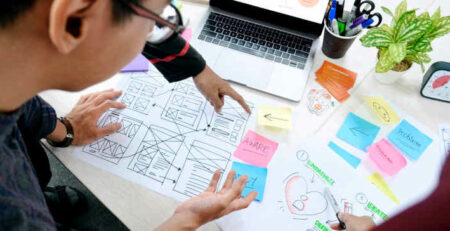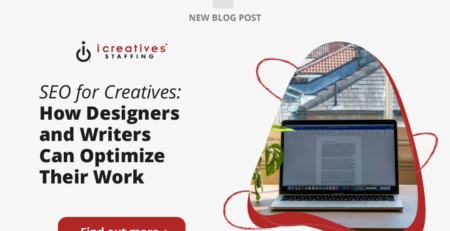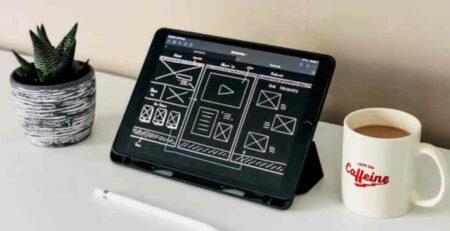Design Thinking for Business Leaders
What exactly do art departments and creative teams do for businesses? This question is often on the mind of stakeholders and other employees who lack a comprehensive understanding of the design thinking that underlies creative work.
Design thinking is a non-linear process used to approach problems from a new perspective based on market research and user input. It creates more diverse brainstorming and unique solutions and makes the product and its delivery more appealing and useful.
Once you have a grasp on the principles of design thinking, communicating with creatives and understanding their solutions will be much simpler, as will thinking of better solutions that are tailored to your business and its target market.
Read on for a full rundown of design thinking and how it’s used to innovate and vitalize products by businesses all over the world.
What is Design Thinking?
A concise definition of design thinking that avoids catchy buzzwords and jargon should provide a solid foundation for understanding its principles.
Design thinking is a multi-stage methodology to collect scattered information into an appealing product that satisfies user needs and desires. Identifying what the users want and the problems they experience – called “pain points” – is an essential part of design thinking. Business goals and design go hand in hand because users engage more with products that are tailored to them.
In case you have an image in your mind of creatives in colorful sweaters sitting around silently pondering, it’s important to note that design thinking is not a mental process but actually a series of action-based stages, which is great for managers and other stakeholders who want to monitor how a project is progressing.
However, there’s much more to this process than its concrete deliverables, which might include prototypes, wireframes, or personas. It also serves as an unparalleled communication and brainstorming tool.

Stages of Designing for Business
Creatives use design thinking for a great number of design products in addition to using it for apps, software, and physical products for companies. The process is similar in all cases but the following description is explained in business-related terms for additional clarity.
1- Empathize
To better meet users’ needs, you have to approach their problems from a place of understanding. Identifying their problems is one thing, but to know how the problems arise and in what ways they affect the lives of your users is another.
Most designers are driven by a general sense of empathy for people and a desire to help them and make their lives more convenient. Even if you don’t personally experience or identify with a given pain point, empathy is vital for viewing the user as a whole, independent person whose problems are valid and worthy of correction.
That might sound like so much false positivity, but consider a caricature of some sort of snake oil salesman – their goal might be to dupe people into purchasing a product instead of building a product that people genuinely want. Empathy is the first step to creating such a product.
2- Define
This second step is in large part a clarification of what was discovered in the first step. User research might be conducted as you define the user’s problems but it can also be done earlier, and designers may draw conclusions from the research in this second stage.
All of the problems identified in the research are collected into problem statements. Designers also build personas to summarize the real users of a product and highlight their most urgent pain points.
Regarding personas: many stakeholders disagree with personas when they first see them because the stakeholder has an idealized version of the people they want to buy the product. The point of personas is not to build an ideal user but rather to illustrate who the real users are.
3- Ideate
Once the problem statements and personas are there, it’s time to get to work brainstorming possible solutions. Brainstorming is nothing new for business professionals, but designers aim to ideate while simultaneously challenging any preconceived notions and prejudices that might produce inadequate solutions.
Too many potential solutions can overwhelm the process and damage its effectiveness, which is why designers frequently prefer to go through the beginning of their brainstorming process without too many people present.
All aspects of the problem statement should be addressed by any solution shortlisted during this third phase. Both business goals and design principles should be taken into account by each possible solution as well.
4- Prototype
Once possible solutions are identified it’s time to test them out. Not all prototypes will be complete products or inclusive of all aspects of the imagined final product. In fact, it’s best to have just enough in the prototype to identify possible failures and rule out the least effective possibilities.
For many stakeholders, prototypes are the single most important deliverable because they are physical results of the work of the designer(s). Don’t focus completely on getting prototypes from designers, though, because they aren’t always warranter. You don’t want your designers spending all their time building prototypes when they could be testing and working toward the final product in other more abstract ways.
5- Test
Of course, the designers and stakeholders shouldn’t be the only ones who determine the success or failure of a product. The users have to see the product or elements of it and give feedback on whether it addresses their problems effectively. The testing stage is where designers have users try out products or certain design elements to see if they work.
A great example of testing is the A/B test, where UX designers will give users two versions of a design to try out. There might only be a single difference, such as the presence or color of a button on a webpage. Users then report which of the options they prefer.
There’s not one stage of testing. Frequently designers will have to go back to the drawing board for tweaks and fixes many times in this process, but that’s a good thing. It means they’re identifying new aspects of the problem and inventing better solutions.
Is Design Thinking a Fixed Sequence?
Design is iterative, which means it’s performed through individual attempts at a design which is then altered based on new information. Because new information comes in so regularly throughout the design process, you can revisit any one of the stages at any point.
For example, you may discover a new aspect of the problem and return to the define stage to write out a more inclusive problem statement. Building a new prototype might require additional brainstorming. It’s entirely possible to discover a deeper empathy for the problem you’re addressing several times in the course of creating a design.
This flexibility is what makes this process so effective at designing for business. Although you might take a meandering route, the general path always leads from identifying users’ problems toward a final product that solves them.
Bias and Design Thinking
Building a product or service for an imagined problem or consumer can go wrong. That’s because someone who imagines a problem based on their own view of things is relying on a limited individual experience that is not likely to be illustrative of other people’s lives.
While there are trends, there is no individual experience that speaks for most people. We think differently, have different personal philosophies, and thus have different priorities. Rather than trying to design one thing that will be received the same way by all people, it’s best to build a flexible product that users can put to a variety of purposes depending on what they need.
For example, if we were building a hypothetical online shopping website, it wouldn’t be necessary to build only one pathway for users to get from the homepage to the shopping cart. Users will rightfully find this brief experience unfulfilling; it will seem as if there is no desire from the company to do anything for the user except sell them something.
Building a website with a wealth of information and tools for comparison, calculations, and user reviews, though, will give the user a much more involved experience. More importantly, it puts the user in control of their own experience. That empowerment is a critical key to make products more appealing.
This isn’t an argument that particular stakeholders or professionals are always tainted with bias, but rather that one of the explicit purposes of design thinking is to identify bias and eliminate it by going straight to the users and getting their opinion. Designers might approach a problem with their own biases but research and testing eliminate the worst of these, provided the testing and research are done correctly.
Design Thinking As a Communication Tool
Managers and other stakeholders may not see how business goals and design work together, but since design thinking is grounded in human experience, it’s a great framework for discussion. Creatives discuss ideas and organize their own thoughts within this context so using it to explain things to non-creatives just makes sense.
Beyond simply explaining ideas to others, design thinking can also be used to solicit solutions from stakeholders who might have ideas about a product or design that they have trouble articulating in a way that’s useful and constructive for designers or a creative team.
Outside specific design projects, the same methodology can be used to identify organizational solutions and build internal business processes that address the problems of employees and management. The way iteration and ideation combine in the process makes it ideal for groups to collaborate on a wide variety of projects.
Benefits of Designing for Business
Not only does design thinking foster healthy communication and reduce the impact of biased thinking, but it also provides an excellent structure that will make projects feel more interrelated. If your company builds up its own brand of design thinking that’s specifically tailored to the company’s brand and products, it can be even more effective at helping to build an office culture.
Here are a few other benefits of merging business goals and design:
- Innovation
The more you address problems through a design thinking framework, the more intuitive the process becomes. Soon, it will be a go-to structure that makes people more comfortable when they’re considering ideas that are new or completely different from previous solutions.
Riskier ideas tend to get tossed out more quickly in the ideation phase, but taking care to label them as potentially risky and keep them around on a kind of backburner if they have significant enough appeal is a great way to use design thinking to innovate.
- Customer Discovery
Identifying users’ problems involves outreach to new potential customers. Centering the user from the very beginning of a project frequently reveals new sections of the market that your business can target. Laying out a customer journey based on research findings can also reveal new ways to cater to the needs and wants of your existing customer base.
It might seem like wishful thinking, but the discovery of new customers and new avenues for reaching existing customers is an inherent result of more interaction with real users. Limited personal perspectives are widened and broadened by design thinking. Users are given the opportunity to express needs and desires that may otherwise not be apparent.
- Social Impact
Collaborating with users when designing new products and services also gives innovators new perspectives on how their target audience lives. That means opportunities for social outreach and more inclusive brand messaging will increase.
The relationship between businesses and society is frequently discussed in business ethics. While opinions as to the degree and nature of corporate responsibility vary, there’s just no denying that concretely improving the lives of customers will make them like your brand and company more. Designing for businesses can be summed up in a few words: Outreach builds better products.
- Unity
Because it goes to such great lengths to gather information on users and their pain points, the design thinking process also helps everyone involved with a project get on the same page. When everyone is starting on even footing, there’s less opportunity for disagreements and a better understanding of the project’s goals will be shared by all.
That’s not to say that people won’t have different or opposing views, but design thinking also provides a great avenue for settling disputes because the information is clearly laid out and universally shared.
- Streamlined Process
Once you start to think like a designer you’ll wonder how you ever got by any other way. The design thinking process is described in stages even though it’s not necessarily linear because it is a standard for organizing the long road from problem identification to product release in a way that saves time and money.
Business products that were invented to look good and impress people simply aren’t on the same level as those that took their users into account from the very beginning. Every product needs a design to be created, but there’s a stark difference between designs that were created for the designers and those that were created for the user.
- Better Products
All the testing and prototyping of design thinking eliminates bugs and product shortcomings that might have been missed otherwise. The first iteration of your product would likely have worse reviews from the people who used it, but the iterations constructed when designing for business eliminate worse products.
This is all done according to the desires and needs of the user. Even if they think they want something, design testing allows you to see how they truly use a product so you can give them what’s actually needed. That might look different than their idea of the product, but if you show them something they didn’t even know they wanted, you’ll have a much more satisfied customer who is more likely to return in the future.

Conclusion:
Business goals and design go hand in hand but far too many executives and shareholders have a hard time seeing how. Basically, if you’re trying to sell something to someone it makes so much more sense to get them involved. This truth is borne out by the success of the most successful companies that have clearly implemented design thinking in their product and branding designs.
Hopefully, this guide has helped clarify exactly what people mean when they talk about design thinking and illustrated some general ways you can use design thinking to make your products more effective and your business more successful.












